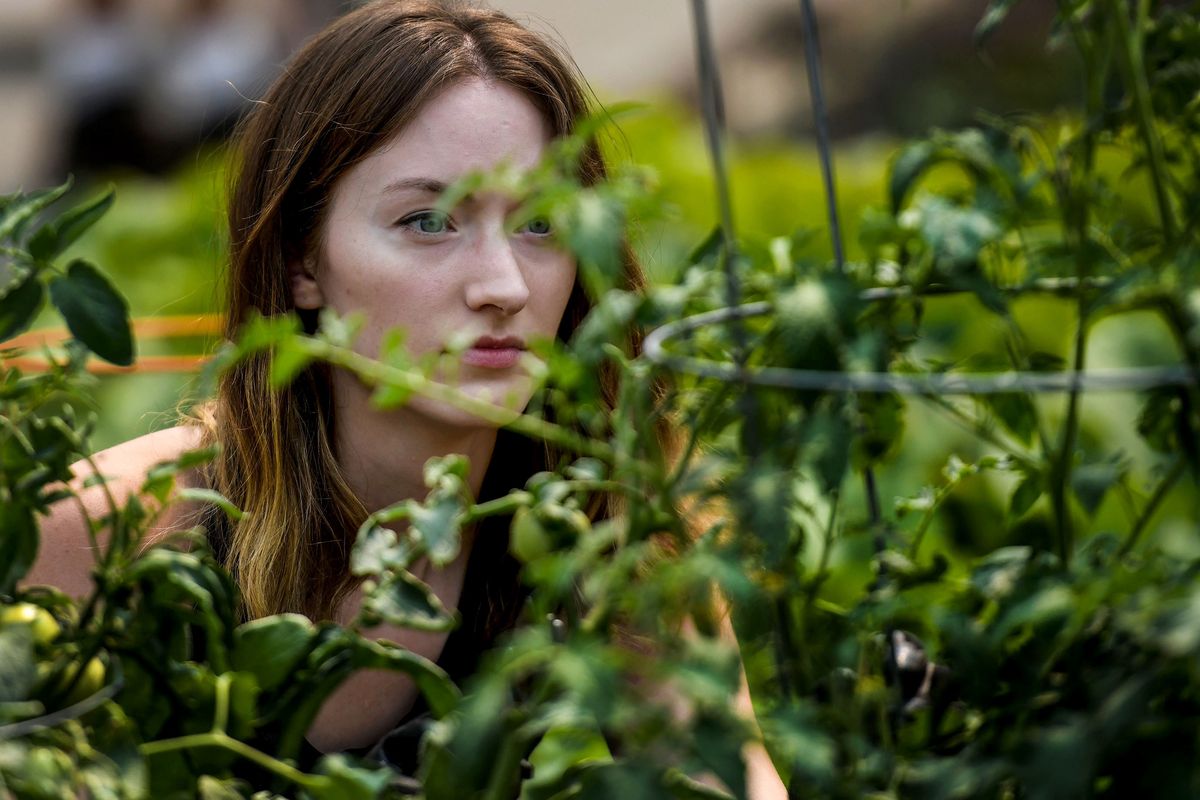‘Something that is beautiful’: Spokane Falls Community College environmental club revives community garden

Weeds. Weeds everywhere.
That was one of the first things Cierra Grove noticed upon surveying what was once a community garden space at Spokane Falls Community College along Elliott Drive near the sports fields.
The site had been used as a garden at least a few years ago, but the space fell into disrepair over the years, with weeds Grove estimated to be as tall as 5 feet.
Over the past several months, however, SFCC’s relatively new environmental club has worked the space back into shape, transforming what was once described as a “wasteland,” according to college staff, back into a functional garden with future plans for a therapeutic space.
“I think it’s important to show people that we can use land in a way that’s aesthetically beautiful and also provides use,” Grove said. “I think it’s just important to show that the land also doesn’t just have to be lawn to be beautiful.”
The efforts of the club, which was chartered last year, were on full display Thursday, as the garden hosted a food giveaway for the college community.
Hosted by SFCC’s Associated Student Government officers through the college’s Food Bank, Thursday’s event saw a number of products, which were donated by Second Harvest, doled to other students, staff and faculty in the campus community. Products pulled from SFCC’s community garden were also distributed.
Some garlic, onions and potatoes from the previous garden were left among the weeds when the club first took on the project earlier this year, said Monica Stenzel, the environmental club’s faculty advisor.
Grove, majoring in environmental science, said cleanup work started in March and was helped in part by a campus cleanup event in the spring.
“We pretty much had to start from scratch,” she said.
Once planting could begin in May, Stenzel said she was interested in growing things that students could connect with, such as traditional salsa ingredients.
“I’ve seen at farmer’s markets where people will just have already measured and bagged, you know, three tomatoes, a chunk of cilantro and some garlic to chop up and pepper it with lime juice,” Stenzel said. “That is a healthy and fun, but also I think student approachable, introduction to growing your own food.”
The garden also includes a borage plant, “a major plant for pollinators,” Grove said. Other products include raspberries, kale, ground cherries and pumpkins, the latter of which Stenzel hopes to use for a Halloween club fundraiser.
Much of the produce is from seeds donated to the club, including donations from SFCC’s biology department and the Salish School of Spokane.
“It was kind of interesting because we didn’t have a budget, so everything that you see here was given to us for free,” Grove said.
Looking ahead, Stenzel said the club is working with SFCC Student Accessibility Services to build out a therapeutic section of the garden, with a pathway, benches, fragrant herbs and possibly a bird bath.
“We’re hoping next year, we can have a lot more input as to specific plants we want in the garden,” she said. “I would love to see native plants planted in the therapeutic side of the garden.”
Grove said she plans to remain involved for a couple of more years at SFCC.
Once the group gets more established, Stenzel said she plans to coordinate programming for the environmental club through guest speakers, internships, movie screenings and other community outreach. She also hopes to connect with other sustainability-centered projects throughout the region, such as those at Gonzaga, Whitworth and Eastern Washington universities.
The garden has been a learning experience for Stenzel and the club’s four students, who have been helped by Andrew Lemberg, SFCC’s resource conservation manager, and Kathryn Graham, an AmeriCorps volunteer.
Stenzel said the club has received a positive response from folks throughout the campus, including those who said they were “tired of looking at the wasteland.”
“What’s been really rewarding about it is that people have responded to it as something that is beautiful,” she said. “And other people are excited that we could grow food for our own community, and other people are excited about having a therapeutic space. We’re trying to use it in as many ways that can be helpful.”